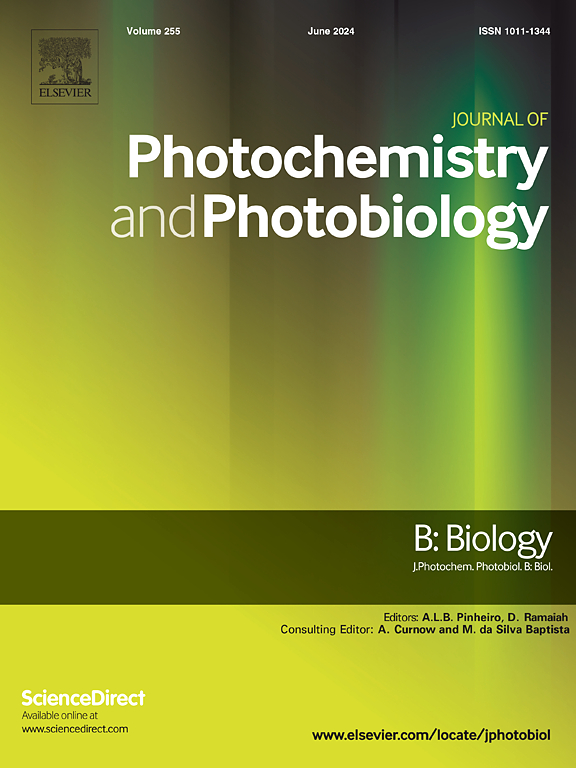新型光敏剂的溶酶体定位和肿瘤靶向性增强了癌症消融效果。
IF 3.9
2区 生物学
Q2 BIOCHEMISTRY & MOLECULAR BIOLOGY
Journal of photochemistry and photobiology. B, Biology
Pub Date : 2024-10-28
DOI:10.1016/j.jphotobiol.2024.113045
引用次数: 0
摘要
溶酶体具有重要功能,但在癌细胞中的脆弱性增加,因此是很有希望的癌症治疗靶点。在此,我们报告了一类含有季铵基团的新型阳离子光敏剂(化合物 1-3)。这些光敏剂表现出对癌细胞的选择性吸收(约为正常细胞的三倍)、溶酶体特异性定位(皮尔逊系数大于 0.85)、显著的光毒性(IC50 在数十 nM 的范围内),同时具有良好的生物安全性。从机理上讲,这些肿瘤靶向光敏剂具有光控 "炸弹 "的功能,可诱导溶酶体膜通透(LMP),最终导致癌细胞凋亡。在体内,化合物 1(这些新型光敏剂的代表)主要积聚在植入小鼠体内的肿瘤中,并使肿瘤可视化。经近红外光照射(50 J/cm2)后,该化合物在 2 mg/kg 的低剂量下就能有效消融肿瘤。我们的研究结果表明,一类新型光敏剂具有综合癌症诊断和光动力治疗的潜力。本文章由计算机程序翻译,如有差异,请以英文原文为准。

Lysosome-localization and tumor-targeting of novel photosensitizers enhance the ablation of cancer
Lysosomes are promising therapeutic targets for cancer therapy due to their essential function and increased vulnerability in cancer cells. Herein, we report a new category of cationic photosensitizers (compounds 1–3) containing a quaternary ammonium group. These photosensitizers exhibited selective uptake on cancer cells (about three times compared to the normal cells), lysosome-specific localization (Pearson's coefficients greater than 0.85), remarkable phototoxicity (IC50 are in the range of dozens of nM), and at the same time, favorable biosafety. Mechanically, these tumor-targeting photosensitizers function as light-controlled “bombs”, inducing lysosomal membrane permeabilization (LMP), ultimately resulting in apoptosis of cancer cells. In vivo, compound 1 (a representative of these novel photosensitizers) accumulated predominantly in and visualized tumors implanted on mice. Upon exposure to near-infrared light irradiation (50 J/cm2), the compound effectively ablated the tumor at a low dose of 2 mg/kg. Our results demonstrate a novel class of photosensitizers showing potential for integrated cancer diagnosis and photodynamic treatment.
求助全文
通过发布文献求助,成功后即可免费获取论文全文。
去求助
来源期刊
CiteScore
12.10
自引率
1.90%
发文量
161
审稿时长
37 days
期刊介绍:
The Journal of Photochemistry and Photobiology B: Biology provides a forum for the publication of papers relating to the various aspects of photobiology, as well as a means for communication in this multidisciplinary field.
The scope includes:
- Bioluminescence
- Chronobiology
- DNA repair
- Environmental photobiology
- Nanotechnology in photobiology
- Photocarcinogenesis
- Photochemistry of biomolecules
- Photodynamic therapy
- Photomedicine
- Photomorphogenesis
- Photomovement
- Photoreception
- Photosensitization
- Photosynthesis
- Phototechnology
- Spectroscopy of biological systems
- UV and visible radiation effects and vision.

 求助内容:
求助内容: 应助结果提醒方式:
应助结果提醒方式:


